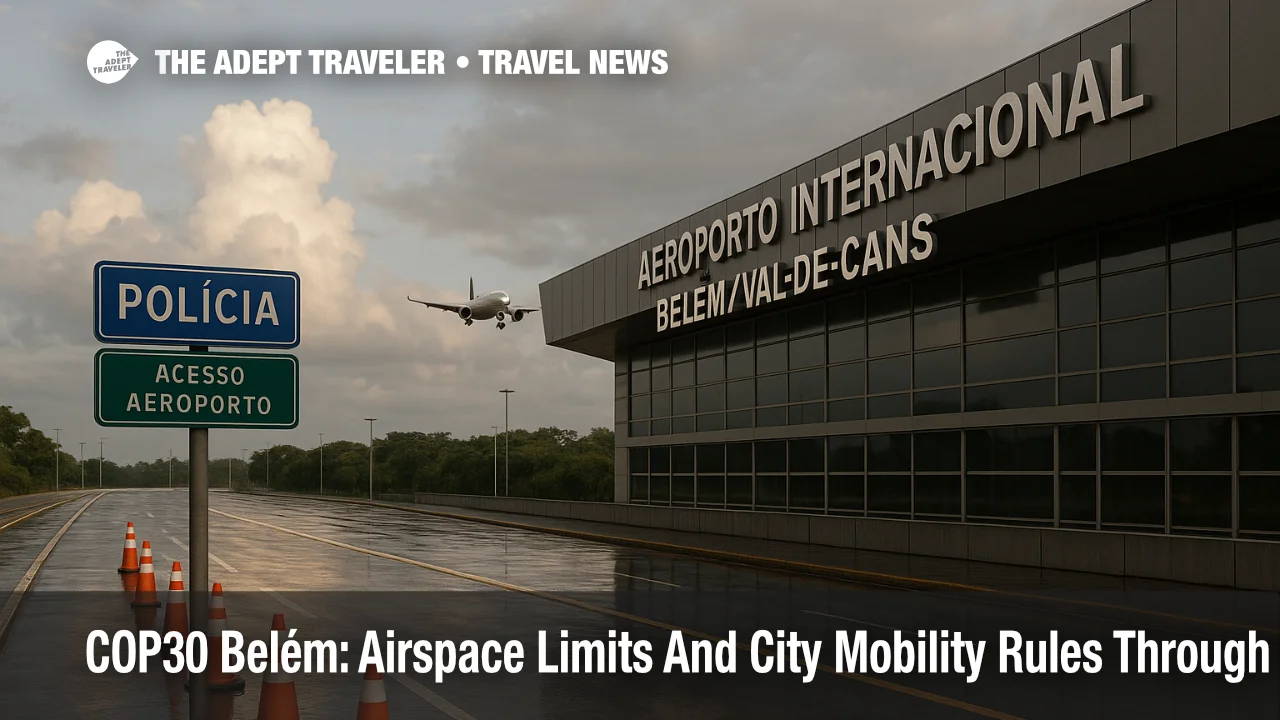COP30 Belém: Airspace Limits And City Mobility Rules Through Nov 21

Key points
- Airspace measures for COP30 activate around Belém with the most restrictive phase November 4-9
- City mobility plan enforces traffic cordons near Parque da Cidade from November 2-21 with diversions and access controls
- SBBE operates as a coordinated aerodrome with limited parking and slot facilitation during the event
- Ride-hailing and taxis are permitted but subject to perimeter checkpoints and designated access points
- Leaders' engagements November 6-7 and the COP30 sessions November 10-21 drive rolling security measures
Impact
- Check Official NOTAMs
- Confirm airspace limitations and any PPR or slot windows before filing
- Allow Extra Transfer Time
- Expect detours and intermittent closures around Parque da Cidade November 2-21
- Confirm Parking And Slots
- Business and charter operators should verify stand availability and facilitation at SBBE
- Plan Ground Access
- Use mapped diversion routes, designated pick up or drop off points, and carry ID for checkpoints
- Monitor Airline Messages
- Watch for schedule adjustments or retimings during the November 4-9 leaders' window
Security and mobility measures tied to COP30 are now active in Belém, Brazil, affecting both flights and city movement through November 21. Around Belém/Val-de-Cans-Júlio Cezar Ribeiro International Airport (BEL), airspace restrictions and coordinated parking or slot controls tighten during the leaders' window November 4-9, with procedural constraints continuing across the main conference dates November 10-21. On the ground, traffic cordons and diversions around Parque da Cidade are in force November 2-21, with designated access points for public transport, taxis, and ride-hailing. Travelers should plan additional time, verify flight notices, and follow posted detours.
Belém air operations and slot posture
Brazilian authorities and trip-support advisories indicate special airspace measures for COP30 spanning the leaders' engagements and the negotiation period, with the most restrictive phase November 4-9 when priority movements are expected to focus on official delegations. Operators should expect limited parking, slot facilitation, and coordinated handling at BEL during the event. Pre-coordination for stands and services is essential, and filed times may be adjusted to align with security flows.
City mobility around Parque da Cidade
The COP30 Mobility Plan details closures and diversions surrounding Parque da Cidade between November 2 and 21, identifying alternative routes, controlled access points, and guidance for pedestrians, cyclists, buses, taxis, and ride-hailing. Municipal notices outline temporary traffic changes on key approaches, bus route adjustments, and restricted curb access near venue gates to preserve secure corridors. Expect intermittent, short-duration closures for official convoys November 4-9 layered on top of all-day restrictions.
Latest developments
Event timelines place leaders' engagements on November 6-7, followed by formal negotiations November 10-21. Authorities emphasize expanded public transport, including dedicated shuttle capacity to the venue and maritime berths used as supplemental lodging, while advising private vehicles to avoid cordoned areas where parking is temporarily restricted. Delegations and visitors are reminded to carry identification and comply with checkpoint instructions throughout the conference footprint.
Analysis
For flight planning, treat BEL as capacity-constrained across the entire window and apply the same discipline used for other high-security summits. Build buffers into departure and arrival sequences, secure ground handling early, and verify stand availability before committing to turn times. For commercial travelers, the operational picture remains stable, but minor retimings are possible during the November 4-9 phase; monitor airline notifications and consider earlier departures on critical days.
On the ground, the simplest tactic is to approach Parque da Cidade via designated corridors using public transport or permitted drop-off points, then walk the final segment inside the soft perimeter. Ride-hailing is allowed where roads remain open, though geofenced access and checkpoint controls may shift pick-up or drop-off to signed areas, so confirm pin locations with the driver before you set out.
Background COP30 runs under UNFCCC schedules November 10-21 in Belém, with federal, state, and municipal plans delivering integrated security and mobility. Local decrees and advisories establish temporary traffic restrictions, convoy windows, and venue cordons, while national air navigation stakeholders coordinate demand and security overlays in the Belém FIR and at BEL.
Final thoughts
COP30 Belém airspace limits and city mobility rules are time-boxed but significant. If your plans touch BEL or Parque da Cidade between November 2 and 21, lock in slots or stands early, travel with extra margin, and use the posted diversion maps to keep movements predictable.
Sources
- COP30 outlines information on traffic, transport, and mobility in Belém during the conference
- UNFCCC, Information for COP30 participants
- UN Climate Change Conference, COP30 overview
- Universal Weather, COP30 Belém 2025: Business Aviation Guide
- CGNA/DECEA Operational Portal, SBBE coordinated aerodrome info
- Prefeitura de Belém, Mobility Plan for COP30
- Prefeitura de Belém, Bus route and terminal adjustments for COP30
- Decreto Municipal Nº 113953, medidas especiais de trânsito e mobilidade
- Message for U.S. Citizens: Travel to Brazil During COP30
